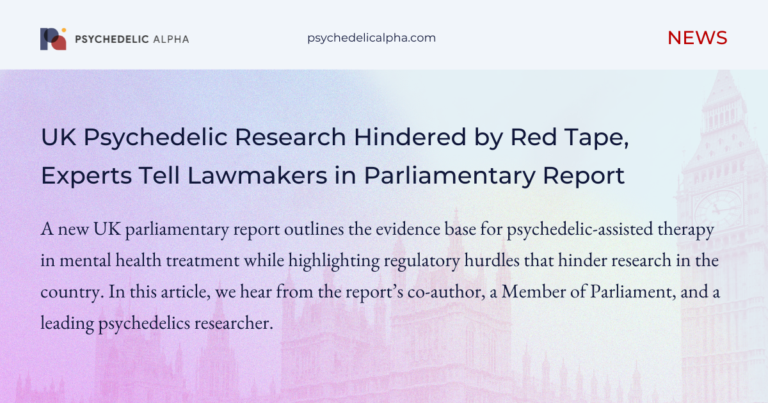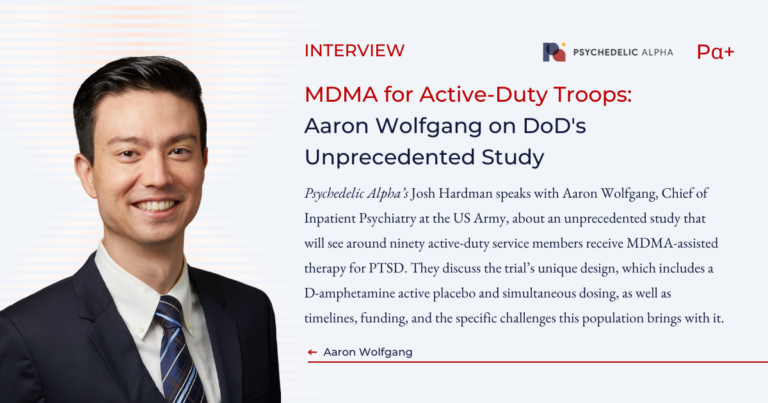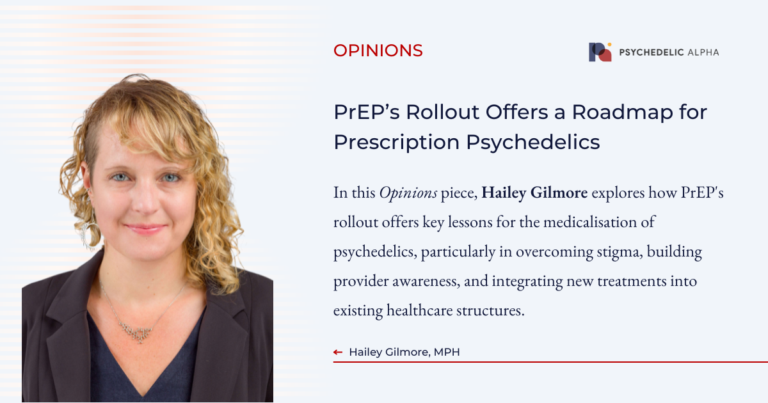Mia Cara Cosco attended Psychedelic Intersections at Harvard earlier this month and provides this Dispatch for Psychedelic Alpha. In her article, Cosco explores some of the major discussions at the event, including what she perceived to be palpable tensions surrounding the roles of science, spirituality, and commercialisation in the psychedelics field.
A guest article by Mia Cara Cosco for Psychedelic Alpha.
The third annual Psychedelic Intersections conference, hosted by Harvard Divinity School’s Center for the Study of World Religions, took place on Saturday, February 15, 2025. This one-day academic gathering brought together scholars, practitioners, and policymakers to explore the intersection of psychedelics and spirituality.
Some of the event unfolded in the James Room, a warm, modern wood-paneled mini-conference hall. Floor-to-ceiling windows allowed the blue evening light to bathe the snow-covered campus, creating a zen-like atmosphere. Charles Stang, Jeffrey Breau, and Paul Gillis-Smith welcomed attendees, setting the stage for a day of interdisciplinary dialogue.
The morning keynote was delivered by Elías García Méndez, co-founder of Casa Adobe, a Mazatec art-focused gallery in Mexico. As García Méndez spoke passionately about the intersection of Indigenous wisdom and modern psychedelic use, I sensed a subtle undercurrent of discomfort in the room. Some attendees nodded enthusiastically with approving smiles, while others stared blankly back or shifted uneasily in their seats. It was a hint of the tensions that would emerge throughout the day – a struggle between embracing traditional knowledge and the push for Western scientific validation.
Tensions in Sharp Focus
The panel on Indigenous Plant Medicine Traditions in the Americas brought certain tensions into sharper focus. As I listened to Andrea Sanchez Castaneda and Nicolle Torres Sierra discuss urban Muysca Indigenous revitalization through sacred plant medicine, I couldn’t help but imagine heated debates lying right underneath the surface of innocent questions on cultural appropriation versus cultural preservation.
“I think you guys are proving my point,” Mayanthi Fernando said with a wry smile, as Harvard students and seasoned researchers alike challenged her critique of disembodied psychedelic experiences. Mayanthi Fernando had presented on “Mushrooms, Mysticism, and the Fantasy of Disembodiment” and in response to one in-person engineer asking “if, it’s a big IF, you could disembody in the psychedelic experience…”, she was quick to cut him off on the Zoom presenter screen looming over us all: “To be disembodied? It’s not human!”
Fair enough. As I watched the back-and-forth, I couldn’t help but reflect on the tension between emphasizing diversity and inclusion versus a more ‘meritocratic’ approach to psychedelic research. The passionate arguments from both sides highlighted the complex interplay between academic theory and lived experience in the field.
Slow Versus Fast Medicine
As sometimes magnified in any event gathering enough people in this controversial, still somewhat taboo movement of psychedelic medicine, there is a struggle between acceptance of the burgeoning psychedelic industry with all its buzzy startups and a more nuanced, sometimes jaded perspective to protect or defend the slow medicine and sacred practices.
Lisa Gezon’s exploration of the intersection between psychedelics, adverse religious experiences, and spiritual healing resonated deeply with many attendees. As I listened to Jamie Beachy, Francis Guerriero, and Wael Garas discuss expectancy and hope in MDMA-assisted therapy, I sensed a collective desire to bridge the gap between clinical approaches and spiritual care. Then again, there was always skepticism noted in the concluding Q&A: Why should we revere the clinical models? What does the DSM carry against the power of the spirit, mystical experiences, and intuitive knowledge? Again, fair enough. A worthy debate I was happy to learn from. As Mian and her co-panellists discussed efforts to decolonize psychedelic research and ensure ethical engagement with Indigenous communities, I observed a range of reactions in the audience. Some nodded vigorously, while others seemed to bristle at the implication that current practices might be problematic.
One student questions Maha Mian and Aidan Seale-Feldman’s examination of psychedelic churches and secular biomedical forces, mentioning ethical questions surrounding the lab once led by Roland Griffiths and the dangers of deifying researchers. And, attendees argued about the role of psychedelic churches in the modern landscape—some say they are legal minefields, others say they jeopardize the progress made in clinical research (and some simply blame them for being too white).
The discussion highlighted yet another fault line in the community – between those who view psychedelics primarily as therapeutic tools and those who see them as sacraments. I can’t help but wonder: is our ego placing psychedelics and every element of psychedelic experiences on a pedestal of ‘healing’ and ‘transformation?’
Burning Woman
The evening keynote by Marian Goodell, CEO of Burning Man Project, was a highlight that brought many of the day’s themes into lighter relief. As Goodell took the stage, resplendent in a neon pink blouse that seemed to radiate energy, I couldn’t help but smile at the irony of her “homecoming” to Harvard – a sentiment she herself acknowledged.
“In a way, I’m coming home,” Goodell said with a grin, referencing her parents’ attendance at Harvard and MIT. But as any Burner will tell you, ‘coming home’ means something very different in Black Rock City.
Her opening video montage of Burning Man, set to pulsing electronic music, transported me back to the playa. For a moment, the academic setting faded away, replaced by dust and art and the promise of awe. As I looked around the room, I saw a mix of reactions – some attendees were clearly moved, while others seemed to regard the spectacle with laughter and smiles of remembrance (like me).
Goodell’s words, “The rain and the wind are the crucible for a transcendent experience,” seemed to encapsulate not just the Burning Man ethos, but the very nature of the psychedelic journey. As she spoke, I reflected on how her presence here, at this academic conference, represented a kind of crucible in itself – a meeting point between counterculture and institution, between lived experience and scholarly inquiry.
In many ways, the Temple at Burning Man serves as a parallel to the academic world of Harvard Divinity School (HDS). Both spaces foster contemplation, community, and spiritual exploration. The Psychedelic Intersections conference exemplifies HDS’s commitment to exploring the frontiers of spirituality and consciousness.
MAPS founder Rick Doblin’s presence seemed to bridge some of the divides I had observed throughout the day. Here was someone who had navigated the worlds of academia, activism, and industry with resilience, persistence, and levity. As I watched him engage with students and researchers alike, I was unsurprised when questions at the end of Marian’s evening keynote regarding the presence of the Zendo Project at Burning Man in future years invited his answer in. (Yes, The Zendo Project is reconsidering Burning Man only because the community of Burning Man is not as “in need” of their harm reduction services as much as other festivals or events are–and during the summer festival season, the effort and energy expended for Burning Man may be better expended elsewhere in that case).
Exploring Those Shadows
The Psychedelic Intersections conference reflects the growing interest in psychedelics across academic disciplines. It brings together the larger Boston community, including psychedelic researchers, guides, and authors, fostering interdisciplinary collaboration. I was happy to meet up-and-coming local psychedelic reporters flocking from the South End, trip-sitters eager to find an afterparty, and Harvard Business School graduates eyeing their next startup idea. This exchange epitomized the tension I had sensed throughout the conference – a struggle between those pushing for greater diversity and inclusion in all aspects of psychedelic research and practice, and those who feared that such efforts might impede scientific progress or lead to a form of ‘reverse discrimination’.
As the conference drew to a close, I found myself both invigorated and unsettled. The Psychedelic Intersections gathering had laid bare the complex web of ideas, aspirations, and conflicts shaping the future of psychedelic studies.
Walking out into the snow-covered Harvard campus, I couldn’t help but feel that I had witnessed a pivotal moment in the evolution of psychedelic studies. The tensions I observed – between acceptance and critique, diversity and ‘meritocracy’, science and spirituality – seemed not just inevitable but necessary for the growth of the field. But as any psychonaut knows, it is often in exploring those shadows that we find our greatest insights and opportunities for growth.
The Psychedelic Intersections conference may have ended, but the conversations it sparked will undoubtedly continue to shape the field for years to come. And I, for one, left feeling both humbled and inspired by the complex, beautiful, and sometimes messy work of expanding the frontiers of human consciousness and healing.
The challenge ahead, I realized, would be to navigate these tensions with wisdom, compassion, and a willingness to embrace the discomfort of transformation. As I left the grounds of Harvard Divinity School, I carried with me a profound sense of the work yet to be done in bridging the many worlds that intersect in the realm of psychedelics.
You might also like…





